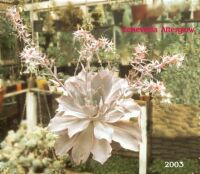 Water Plenty
of water in growing times but soil must be well drained. They will
rot if kept too wet.
Water Plenty
of water in growing times but soil must be well drained. They will
rot if kept too wet.Hobart John
Marie's page #2
Echeverias
Echeverias are a member of the family crassulaceae and are winter growers.
Their habitat is southern and eastern states of Mexico, Puebla, Vera Cruz, San Luis, Potosi and Oaxaca. E Strictiflora comes from Texas.
They are found on cliff faces, rocky hillsides among bush and pine forests in various degrees of exposure and shape. Two types of Echeverias exist, the true species and the many hybrids, which continue to increase in number each year.
The true species IE., Elegans and Albicans, Nixiana, Agavoides etc are wonderful border plants and just keep on pupping for years. Two true species however that don't do this are Lauii and S Mexico or as it is know down southern states, Mexico Giant. Both are reluctant to pup and both need much less water than the others as they rot at soil level easily. Requirements for well grown plants are light, water and food.
The photo is of my Echeveria Afterglow.
Light. A preference of morning light and bright light for the remainder of the day.
 Water Plenty
of water in growing times but soil must be well drained. They will
rot if kept too wet.
Water Plenty
of water in growing times but soil must be well drained. They will
rot if kept too wet.
Food I use Searles Premium Potting Mix which I break down with course river sand and re-pot every year.
Many growers use phostergen at half strength during their growing season. The hybrid Echeverias need more attention as they tend to get long stemmed so you need to behead them each year. I usually do this around May as they come into their best growing period.
Cut the head leaving a couple of leaves on the stalk, (don't throw the base away). Let the top sit in an empty pot for at least a week then pot into a clean pot and mix.
The bottom section you can place under the bench and if you are lucky they will produce pups.
The other method of raising more plants is when they send up their long flower stalks, remove the flower head just before the flowers open, cut the stalk into segments and push into the soil. They will root and usually produce pups from the leaf axil. One more reason for removing the flower stalks from hybrids is that they can put up as many as four stalks a metre in length, these sap the plant of energy and your cabbage size plant will usually get smaller.
Flowers are ranging in colour from yellow to red and make a good vase of flowers as they last a long time.
Pests are mealy bug, grasshoppers and grubs and in winter when we get lots of rain, mildue can destroy your plant very quickly. Mealy bug can be controlled by the use of Confidor sprayed directly on the plant.
Don't buy the ready mixed Confidor it is not strong enough. Buy the packet of three sachets and mix according to the directions. If only a few mealy bug are present, a dab with methylated spirits on a cotton bud will do the trick. Mildue must be sprayed with Benlate or it will spread very quickly on dull days to all your plants.
Grubs can only be controlled by checking your plants before they eat too many leaves., they love going up or down the centre so you can loose the entire plant.
Dudleya
As they are also in the Crassulaceae family, I grow these the same (way) as Echeverias. Except they need even more care in summer not to overwater. I find if you behead them they don't like putting down new roots.
The flowers are white and no where near as pretty as the Echeverias.
One thing you should not do is water over head as you will wash off the bloom, the white powder like appearance on the leaves is there for protection from the sun and once removed the plant will not replace the white on that area. This genera is also not as easy to obtain as Echeverias. Both genera can be raised by seed but I find it difficult as the seed is like dust.
Marie D'Alton.
========== end ==========
To go back to my main page #1 click this
“MAD02”
----------------------------------------------------